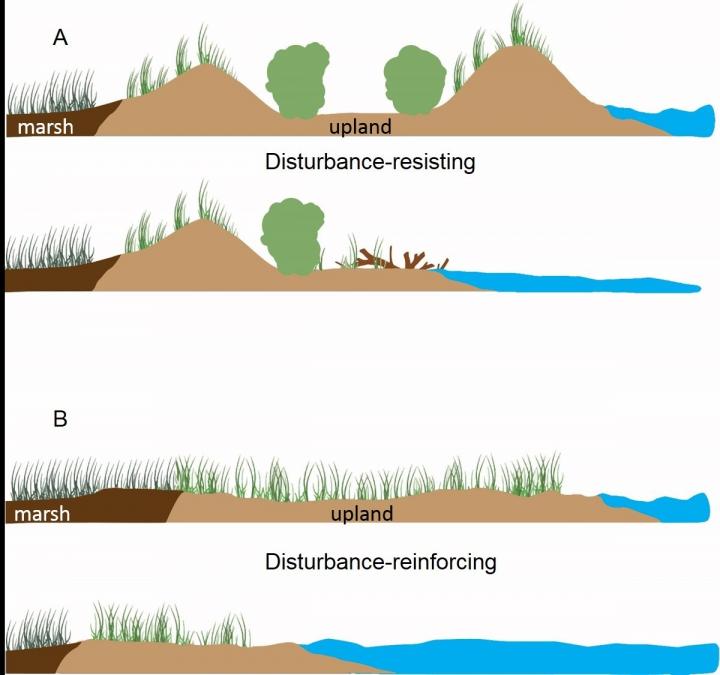
Credit: VCU
A new study of Virginia’s barrier islands off the coast of the Eastern Shore provides a fundamental understanding of how barrier islands will change in the near future amid a warming climate, sea-level rise and storm events such as hurricanes and nor’easters.
The study by researchers with the Coastal Plant Ecology Lab at Virginia Commonwealth University offers important insights into the ecological and geomorphic processes occurring on Virginia’s chain of 23 uninhabited islands stretching from Assateague at the Maryland border to Fisherman Island near the Chesapeake Bay Bridge-Tunnel, as well as other barrier islands along the East Coast that help protect the mainland from storms that — thanks to climate change — are increasing in frequency and intensity.
Barrier islands have been shown to be naturally resilient in response to relative sea-level rise by migrating landward via an “overwash” process that deposits sediment onto the islands’ backbarrier marsh, thereby maintaining elevation above sea level.
This study, which explored the role of interior island vegetation in this process, found that sediment movement from upland to marsh is being stymied by an expansion of woody vegetation brought about by a warming winter climate.
In other words, the impact of sea-level rise on barrier islands in Virginia and elsewhere along the Atlantic Coast is being accelerated by climate change.
“In coastal systems, ecology has pretty much been ignored and we are showing that a species which is expanding specifically due to climate warming is fundamentally changing island migration,” said Julie Zinnert, Ph.D., principal investigator with the Coastal Plant Ecology Lab and assistant professor in the Department of Biology in the College of Humanities and Sciences. “This paper underscores the importance of looking at change across all sub-environments on a barrier island and not just beach shoreline erosion.”
The study shows how the interplay between elevation and interior island vegetative cover influences landward migration of the boundary between upland and marsh — a previously underappreciated indicator that an island is migrating — and, thus, the importance of including ecological processes in the island interior into coastal modeling of barrier island migration and sediment movement across the barrier landscape, Zinnert said.
The study, “Connectivity in coastal systems: barrier island vegetation influences upland migration in a changing climate,” will be published in a forthcoming issue of the journal Global Change Biology.
The research was supported by National Science Foundation Long-Term Ecological Research grants DEB-1237733 and DEB-1832221 and a VCU Presidential Research Quest Fund grant.
“This study is a reminder of the interconnectedness of what people often see as separate ecosystems,” said Colette St. Mary, a National Science Foundation Long-Term Ecological Research program director. “For example, coastal plant communities alter wind patterns and other variables, in turn shaping offshore islands. To address the effects of our changing environment, we need to understand this interconnectivity.”
The research took place at NSF’s Virginia Coast Reserve LTER site, one of 28 such sites at which more than 2,000 researchers apply long-term observation, experiments and modeling to understand how ecological systems function over decades.
As part of the study, the researchers used satellite imagery over a 32-year period (1984-2016) to show that Virginia barrier islands experienced gains and losses of backbarrier marsh and upland, with a 19% net loss.
They also found that macroclimatic winter warming resulted in a 41% increase in woody vegetation in protected, low-elevation areas, introducing new ecological scenarios that increase resistance to sediment movement from upland to marsh.
“We hypothesize that recent woody expansion is altering the rate of marsh to upland conversion,” the researchers wrote.
###
In addition to Zinnert, the study was conducted by Stephen Via, Ph.D., now an assistant professor at Norfolk State University, but formerly a doctoral student at VCU; Ben Nettleton, a VCU master’s degree in biology graduate and now a Virginia Sea Grant policy fellow; Philip Tuley, a VCU master’s degree in biology student; Laura Moore, Ph.D., associate professor of geological sciences at the University of North Carolina at Chapel Hill; and J. Anthony Stallins, Ph.D., associate professor of geography at the University of Kentucky.
Media Contact
Brian McNeill
[email protected]
Original Source
https:/
Related Journal Article
http://dx.




